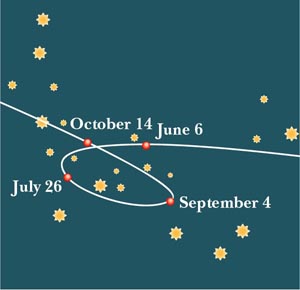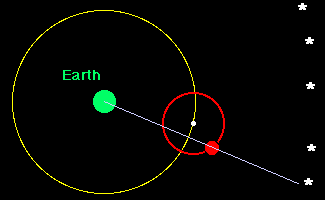
Motion of Sun:
When we look at the sun it seem to be moving around us in a circle, the vector SE (the straight line drawn from earth (E) to sun (S)) rotate with its earth end (E) fixed.
Motion of Mars:
When we look at mars it seem to be describing a "loop-the-loop" motion (also known as retrograde motion) as shown in the picture below:

This puzzle (retrograde or loop-the-loop motion of mars as observed from earth) is easily explained in the above physlet by comparing the motion of the planet mars in the two models: heliocentric and geocentric. Watch the vector EM (the green line drawn from earth to mars) in both models as the simulation runs. In geocentric model the the E end of this vector is fixed, whereas in the heliocentric model it moves around the sun; however in both models the vector EM remains identical to each other at any given time (same length. and direction). The relative positioning of all three (sun, earth and mars) is the same in both models throughout. Thus the retrograde motion of the mars confirm the heliocentric model.
There was an earlier attempt (developed by Ptolemy (87 - 150 A.D.)) to explain this retrograde motion: here the planets moved around small circular paths (epicycles) that in turn moved around larger circular orbits around the Earth. This accounts for retrograde motion, as shown in the animation below:

In its final form, the model was extremely complicated, requiring many nested levels of epicycles, and with even the major orbits offset so that they were no longer truly centered on the Earth. Despite all of this fine tuning, there remained significant discrepancies between the actual positions of the planets and those predicted by the model.